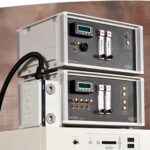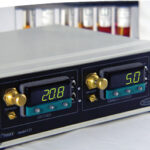Gas Control in Semi-sealed Chambers
Dalton in the Incubator

We are all familiar with how CO2 is infused into cell culture incubators to raise CO2 to physiologic levels and keep carbonic acid based media in the proper pH range for cells. However, managing a system for a gas infusion system necessitates understanding how mixed gases work in a semi-sealed cell incubator chamber.
What gases are added to the room air atmosphere inside the chamber?
In addition to CO2, nitrogen is commonly used to drive O2 levels down from room air to physiologically-relevant oxygen levels. Oxygen is another gas often infused to raise O2 above room air levels or to provide better control of O2 levels when other gases are being infused. Also, the standard open water pan in a humidified incubator infuses the incubator with water vapor that takes up gas volume in the enclosed space.
Incubators and C-Chamber subchambers inside those incubators are semi-sealed
When gas is infused, we don’t want the incubator or subchamber to be pressurized above ambient air pressure. Remember the old nitrogen “bombs” designed to lyse cells by pressurizing and then explosively decompressing them? That’s not the effect we want to have on cells when we open the incubator door. So there is a release mechanism for excess gas pressure.
In the case of most standard room-air incubators, there is a hole in the insulating incubator wall, often with a thick foam plug. This hole allows excess gas pressure to release into the room.
In the case of a C-Chamber subchamber inside the incubator, there is a magnetic seal on the door. When pressure rises in the chamber, the door “burps” slightly. The door flexes, opening the seal just enough to release the pressure, and then re-seals magnetically. This protects the cells from being pressurized by the infusion of gases.
Some C-chambers also have a gas-releasing valve and hose barb on the back that allows escaping gases to be directed outside of the incubator with tubing. This has the advantage that gas released from the subchamber will not affect the gas content of the rest of the incubator where other cells may be housed.
When one gas is infused, the partial pressure of all of the other gases in an enclosed volume changes
This is where Dalton comes in. Dalton’s Law states that the pressure of a mixed gas is the sum of all of the partial pressures of the component gases.
Pgas1 + Pgas2 + Pgas3 = Ptotal
This means that when CO2 is infused into a chamber, the partial pressure of O2 decreases as a percentage. Also, when humidity is high, the partial pressure of O2 is reduced.
↑PCO2 + ↑Pwater + ↓PO2 = Ptotal
The semi-sealed nature of the incubator or chamber means that actual gas pressure does not increase above ambient pressure as gas is infused, just the percentage of each component of the mixed gases change.
While atmospheric oxygen at sea level is accepted to be about 20.8%, O2 in the humidified CO2 incubator is lower. We have measured O2 levels in standard CO2-controlled, humidified room air incubators (n=4 in 3 different institutions), and found 17-19% O2.
Infusing N2 to dilute O2 also drives down CO2
↑PN2 + ↓PO2 + ↓PCO2 = Ptotal
When we want physiologically relevant levels of oxygen, we can infuse N2 to dilute the room air oxygen in the chamber. However, this also drives down CO2 as a percentage. To to keep CO2 levels up at physiologic levels, CO2 has to be infused along with N2.
There are two different approaches to managing CO2 levels during N2 infusion; using a pre-mixed N2 /CO2gas with a single controller and using individual pure gases with multiple controllers.
↑PN2 + ↑PCO2+ ↓PO2 = Ptotal
Using pre-mixed gases can be problematic for reducing oxygen
If a lab will only ever use one level of oxygen that is lower than ambient, then a single-controller pre-mixed gas system can be used. The single gas controller will infuse the tanked gas mixture as needed to dilute out the oxygen inside the chamber to the desired level. With the correct calculations, both the O2 and the CO2can be controlled to the desired level using a mix of N2 and CO2.
Pre-mixed gas formulations are tricky
You have to order a mix with more CO2 than you would expect because you are using the tanked pre-mixed gas to dilute the atmospheric gases already there. Because of the semi-sealed nature of the chamber, you never get 100% of the atmospheric air out and atmospheric air contains very little (<1%) CO2, so you have to compensate by increasing the CO2 in the pre-mix. For example, if you want 5% CO2 and 5% O2 in your chamber, you should order a pre-mix containing 6.58% CO2 and the balance N2 to dilute the gases already there.
Pure gases are less expensive
We encourage scientists to establish systems using pure gases and with multiple controllers because those gases are far cheaper than custom pre-mixed gases. They are also much easier and faster to obtain than custom pre-mixes.
Pure gas usage is more flexible
With multiple gas controllers and pure gases, experiments can be more flexible in design and there will be no need to order and wait for custom pre-mixed gases. There is also no need to switch between different pre-mixes for different conditions. You only need to change the settings on the controller. Nitrogen can also be obtained in liquid form for users needing larger volumes, reducing the number of tanks and the number of deliveries.
Over the long term, it is far easier and less expensive to manage the consumables of a pure gas, multiple-controller system for oxygen control.
Any questions? Contact us here at the Cytocentric Blog.
Recent Articles

Cytocentric Visionaries Hal Broxmeyer
Cytocentric Visionaries: Hal Broxmeyer November 27, 1944 ~ December 8, 2021 Hal Broxmeyer telling Randy Yerden about his latest findings in June 2016. The average height of the Cytocentric researcher has been reduced, now that we have lost a giant. Hal Broxmeyer died...

Cytocentric Visionaries: Dr. David Gozal, MD – Part Two
Cytocentric Visionaries: Dr. David Gozal, MD Part 2: COVID-19 Research, Prone Positioning, and Chronoadequacy Alicia Henn, PhD MBA, Chief Scientific Officer, BioSpherix David Gozal, MD, MBA, PhD (Hon) is the Marie M. and Harry L. Smith Endowed Chair and Chairperson of...

Cytocentric Visionaries: Dr. David Gozal, MD – Part One
Cytocentric Visionaries: Dr. David Gozal, MD Part 1: COVID-19, ACE2, and the Circadian Clock Alicia Henn, PhD MBA, Chief Scientific Officer, BioSpherix David Gozal, MD, MBA, PhD (Hon) is the Marie M. and Harry L. Smith Endowed Chair and Chairperson of the Department...
About The Author
Alicia D Henn, PhD, MBA
Chief Scientific Officer of BioSpherix, Ltd
Alicia Henn has been the Chief Scientific Officer of BioSpherix, Ltd since 2013. Previously, she was a researcher at the Center for Biodefense Immune Modeling in Rochester, NY. Alicia obtained her PhD in molecular pharmacology and cancer therapeutics from Roswell Park Cancer Institute in Buffalo, NY and her MBA from the Simon School at University of Rochester in Rochester, NY.
If you would like to be featured in our Cytocentric Visionary Series, contact us. We would love to hear about your work.





































